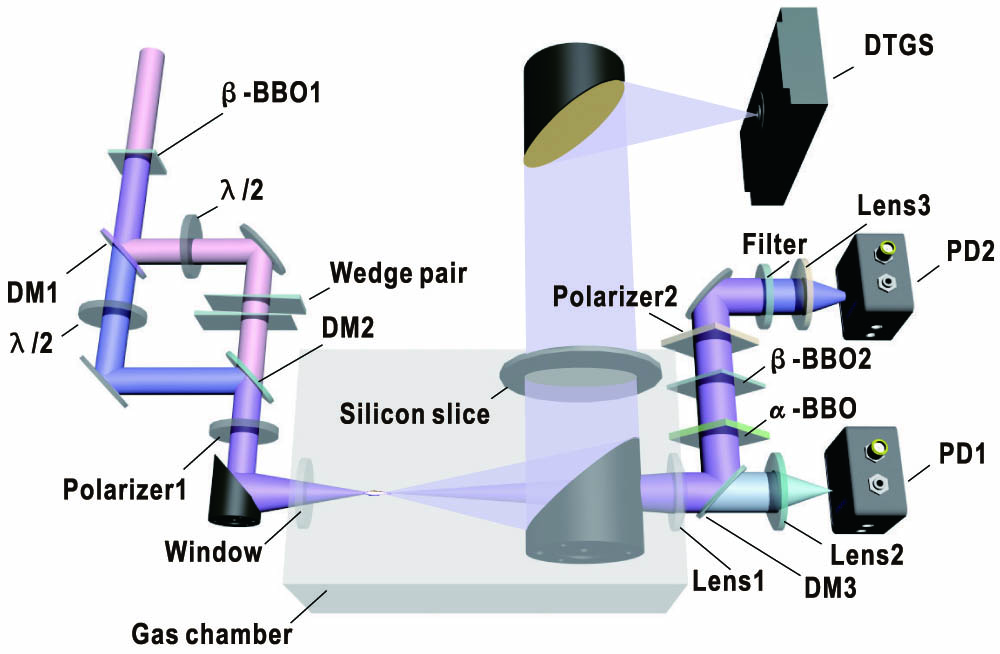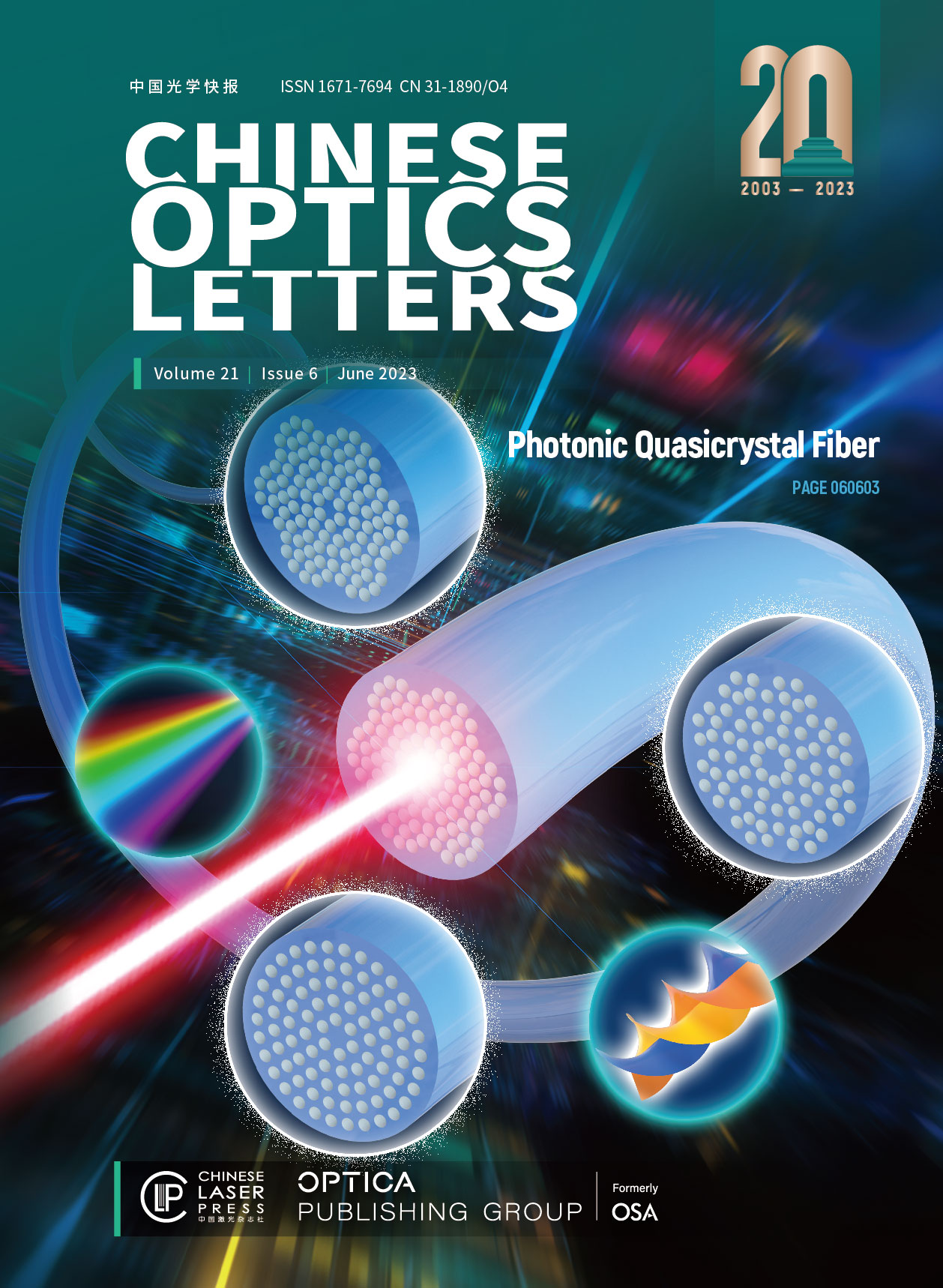2023, 21(5) Column
Atomic and Molecular Optics Fiber Optics and Optical Communications Imaging Systems and Image Processing Instrumentation, Measurement, and Optical Sensing Integrated Optics Lasers, Optical Amplifiers, and Laser Optics Optical Materials Biophotonics Optical Design and Fabrication X-ray Optics Nanophotonics, Metamaterials, and Plasmonics
Chinese Optics Letters 第21卷 第5期
We experimentally demonstrate third-harmonic generation (THG) in gases ionized by a femtosecond laser pulse superimposed on its second-harmonic (SH). The mechanism of THG has been investigated, and it demonstrates that a third-order nonlinear process dominates at low pump intensity. Asymmetric third-harmonic (TH) spectra are observed at different time delays in two color fields, which are attributed to the process of the four-wave mixing (FWM) of the broad spectrum of pump pulses. A joint measurement on the terahertz (THz) and the TH is performed. It reveals that the optimized phase for the THG jumps from 0 to
third-harmonic generation THz In this Letter, the optical amplification characteristics of the home-made Bi/P co-doped silica fiber were systematically explored in the range of 1270–1360 nm. The maximum gain of 24.6 dB was obtained in the single-pass amplification device, and then improved to 38.3 dB in the double-pass amplification device for
Bi/P co-doped silica fiber fiber amplifier O-band amplification fiber laser In this paper, we propose and experimentally demonstrate a joint shaping technique to improve the performance of a low-resolution transmission system for the first time, to the best of our knowledge. The joint shaping technique combines probabilistic shaping (PS) and error feedback noise shaping (EFNS). In the 40-Gbaud intensity-modulation direct-detection (IM/DD) experimental transmission system, a bit-error-rate (BER) of
optical fiber communication quantization digital signal processing Polarized hyperspectral imaging, which has been widely studied worldwide, can obtain four-dimensional data including polarization, spectral, and spatial domains. To simplify data acquisition, compressive sensing theory is utilized in each domain. The polarization information represented by the four Stokes parameters currently requires at least two compressions. This work achieves full-Stokes single compression by introducing deep learning reconstruction. The four Stokes parameters are modulated by a quarter-wave plate (QWP) and a liquid crystal tunable filter (LCTF) and then compressed into a single light intensity detected by a complementary metal oxide semiconductor (CMOS). Data processing involves model training and polarization reconstruction. The reconstruction model is trained by feeding the known Stokes parameters and their single compressions into a deep learning framework. Unknown Stokes parameters can be reconstructed from a single compression using the trained model. Benefiting from the acquisition simplicity and reconstruction efficiency, this work well facilitates the development and application of polarized hyperspectral imaging.
full-Stokes single compression deep learning reconstruction polarized hyperspectral imaging Multi-channel detection is an effective way to improve data throughput of spectral-domain optical coherence tomography (SDOCT). However, current multi-channel OCT requires multiple detectors, which increases the complexity and cost of the system. We propose a novel multi-channel detection design based on a single spectrometer. Each camera pixel receives interferometric spectral signals from all the channels but with a spectral shift between two channels. This design effectively broadens the spectral bandwidth of each pixel, which reduces relative intensity noise (RIN) by
optical coherence tomography multiple channels fiber-optic sensor imaging system We proposed and experimentally demonstrated an all-fiber sensor for measuring bend with high sensitivity based on a ring core fiber (RCF) modal interferometer. The sensor was fabricated by splicing a segment of RCF between two pieces of multimode fiber (MMF) and single-mode fiber (SMF) at the ends of the MMF as lead-in and lead-out. Due to the first segment of the MMF, the transmitted light is coupled into the ring core, silica center, and cladding of the RCF, exciting multiple modes in the RCF. By the modal interferences in the structure, bending sensing can be realized by interrogating the intensity of the interference dip. Experimental results show a high bending sensitivity of
optical fiber sensor curvature temperature ring core fiber The microring resonator based on lithium niobate on insulator (LNOI) is a promising platform for broadband nonlinearity process because of its strong second-order nonlinear coefficients, the capability of dispersion engineering, etc. It is important to control the energy transmitted into the resonator at different wavelengths, as this becomes difficult for two bands across an octave. In this Letter, we study the effect of different pulley bus-resonator configurations on phase mismatching and mode field overlap. We achieve the control of energy transmission coefficients at different wavebands simultaneously and provide a general design methodology for coupled structures for broadband applications. This paper can contribute to quantum and classical optical broadband applications based on LNOI microring resonators.
lithium niobate on insulator broadband pulley bus waveguide coupled mode theory A high-energy 100-Hz optical parametric oscillator (OPO) based on a confocal unstable resonator with a Gaussian reflectivity mirror was demonstrated. A KTA-based OPO with a good beam quality was obtained when the magnification factor was 1.5, corresponding to the maximum signal (1.53 µm) energy of 56 mJ and idler (3.47 µm) energy of 20 mJ, respectively. The beam quality factors (M2) were measured to be M2x = 5.7, M2y = 5.9 for signal and M2x = 8.4, M2y = 8.1 for idler accordingly. The experimental results indicated that the beam quality positively changed with the increase of magnification factors, accompanied by an acceptable loss of pulse energy.
optical parametric oscillators confocal unstable resonator beam quality High-repetition rate femtosecond lasers are shown to drive heat accumulation processes that are attractive for femtosecond laser-induced subwavelength periodic surface structures on silicon. Femtosecond laser micromachining is no longer a nonthermal process, as long as the repetition rate reaches up to 100 kHz due to heat accumulation. Moreover, a higher repetition rate generates much better defined ripple structures on the silicon surface, based on the fact that accumulated heat raises lattice temperature to the melting point of silicon (1687 K), with more intense surface plasmons excited simultaneously. Comparison of the surface morphology on repetition rate and on the overlapping rate confirms that repetition rate and pulse overlapping rate are two competing factors that are responsible for the period of ripple structures. Ripple period drifts longer because of a higher repetition rate due to increasing electron density; however, the period of laser structured surface is significantly reduced with the pulse overlapping rate. The Maxwell–Garnett effect is confirmed to account for the ripple period-decreasing trend with the pulse overlapping rate.
laser materials processing femtosecond laser subwavelength periodic surface structures A monolithic visible supercontinuum (SC) source with a record average output power of 204 W and a spectrum ranging from 580 nm to beyond 2400 nm is achieved in a piece of standard telecom graded-index multimode fiber (GRIN MMF) by designing the pumping system. The influence of the GRIN MMF length on the geometrical parameter instability (GPI) effect is analyzed for the first time, to the best of our knowledge, by comparing the SC spectral region dominated by the GPI effect under different fiber lengths. Our work could pave the way for robust, cost-effective, and high-power visible SC sources.
visible supercontinuum high-power supercontinuum graded-index multimode fiber geometrical parameter instability nonlinear optics Intracavity third-harmonic generation in a continuous-wave/self-mode-locked semiconductor disk laser
The high peak power of picosecond pulses produced by a self-mode-locked semiconductor disk laser can effectively improve the efficiency of nonlinear frequency conversion. This paper presents the intracavity frequency tripling in a self-mode-locked semiconductor disk laser, and a picosecond pulse train at 327 nm wavelength is achieved. The pulse repetition rate is 0.49 GHz, and the pulse width is 5.0 ps. The obtained maximum ultraviolet output power under mode locking is 30.5 mW, and the corresponding conversion efficiency is obviously larger than that of continuous-wave operation. These ultraviolet picosecond pulses have high spatial and temporal resolution and can be applied in some emerging fields.
third-harmonic generation self-mode locking semiconductor disk laser ultraviolet Bismuth (Bi)-doped near-infared (NIR) glass that can cover the entire optical communication window (850, 1310, and 1550 nm) has become the subject of extensive research for developing photonic devices, particularly, tunable fiber lasers and ultrabroadband optical amplifiers. However, the realization of highly efficient NIR luminescence from Bi-doped glass is still full of challenges. Notably, due to the co-existence of multiple Bi NIR centers in the glass, the origin of newly generated Bi NIR emission peaks at ∼930 and ∼1520 nm is still controversial. Here, we report a new Bi-doped nitridated germanate glass with tunable ultrabroadband NIR emission (850–1700 nm) and high external quantum efficiency (EQE) of
bismuth germanate glass near-infrared luminescence Dysprosium-doped orthorhombic yttrium aluminate (
Dy:YAP crystal white-light emitting large crystal growth Rare-earth-doped upconversion (UC) materials are ideal candidates for solar photovoltaic conversion and NIR response devices due to their unique spectral conversion properties. However, their low efficiency remains a tremendous challenge for practical applications. Here, we constructed an efficient NIR light-responsive device by coating a Si-photoresistor with a transparent gel consisting of UC powders and an organic polymer matrix. We show that reasonable introduction of alkali metal ions (
rare-earth-doped upconversion materials solar photoelectric conversion NIR response devices doping with alkali metals Multiphoton microscopy is the enabling tool for biomedical research, but the aberrations of biological tissues have limited its imaging performance. Adaptive optics (AO) has been developed to partially overcome aberration to restore imaging performance. For indirect AO, algorithm is the key to its successful implementation. Here, based on the fact that indirect AO has an analogy to the black-box optimization problem, we successfully apply the covariance matrix adaptation evolution strategy (CMA-ES) used in the latter, to indirect AO in multiphoton microscopy (MPM). Compared with the traditional genetic algorithm (GA), our algorithm has a greater improvement in convergence speed and convergence accuracy, which provides the possibility of realizing real-time dynamic aberration correction for deep in vivo biological tissues.
multiphoton microscopy 1700-nm window adaptive optics covariance matrix adaptation evolution strategy We implement Monte Carlo-based parallel ray tracing to achieve quick irradiance evaluation for freeform lenses with non-uniform rational B-splines (NURBS) surfaces. We employ the inverse transform sampling method to sample rays uniformly from the Lambertian light source and adopt the analytical form of the B-spline basis function to achieve fast surface interpolation. When performing parallel calculations for the intersections between the rays and the NURBS surfaces, we propose a parameter transformation method to avoid the parameters escaping from the defined range in the iteration process. Simulation results of two complex picture-generating freeform lenses show that our method is fast and effective.
propagation methods computation methods nonimaging optics lenses In this paper, the influence of the delay time between the pre-pulse and the main pulse on the double-pass amplified 46.9 nm laser was studied for the first time, to the best of our knowledge, by using a high-precision polished SiC slice as a rear mirror. The temporal and spatial characteristics of the output laser were measured separately to investigate the effect of the delay time on the laser characteristics. The energy of the double-pass amplified laser was between 510 µJ and 890 µJ. In addition, a theoretical model of double-pass amplification was established to analyze the effect of the delay time on the double-pass amplified 46.9 nm laser.
double-pass amplification delay time 46.9 nm laser capillary discharge 动态信息
动态信息 丨 2024-04-19
COL Highlight (Vol. 22, Iss. 2): 主编推荐 | 经典导波与拓扑单向波间的高效转换动态信息 丨 2024-04-19
COL Highlight (Vol. 22, Iss. 1): 主编推荐 | 单片集成硅基灵活栅格MWSS为突破“容量危机”提供新策略动态信息 丨 2024-04-10
COL 封面故事 (Vol. 22, Iss. 2): 封面 |构造任意自相似类贝塞尔光束构造新方法动态信息 丨 2024-03-29
COL Highlight (Vol. 22, Iss. 2): 主编推荐 |声光调制的干涉增强效应,助力光学量子信息技术动态信息 丨 2024-03-25
COL 封面故事 (Vol. 22, Iss. 1): 基于时空耦合效应的超宽带频率转换技术激光评论微信公众号

点击菜单“联系编辑”即可添加期刊编辑为好友啦


























